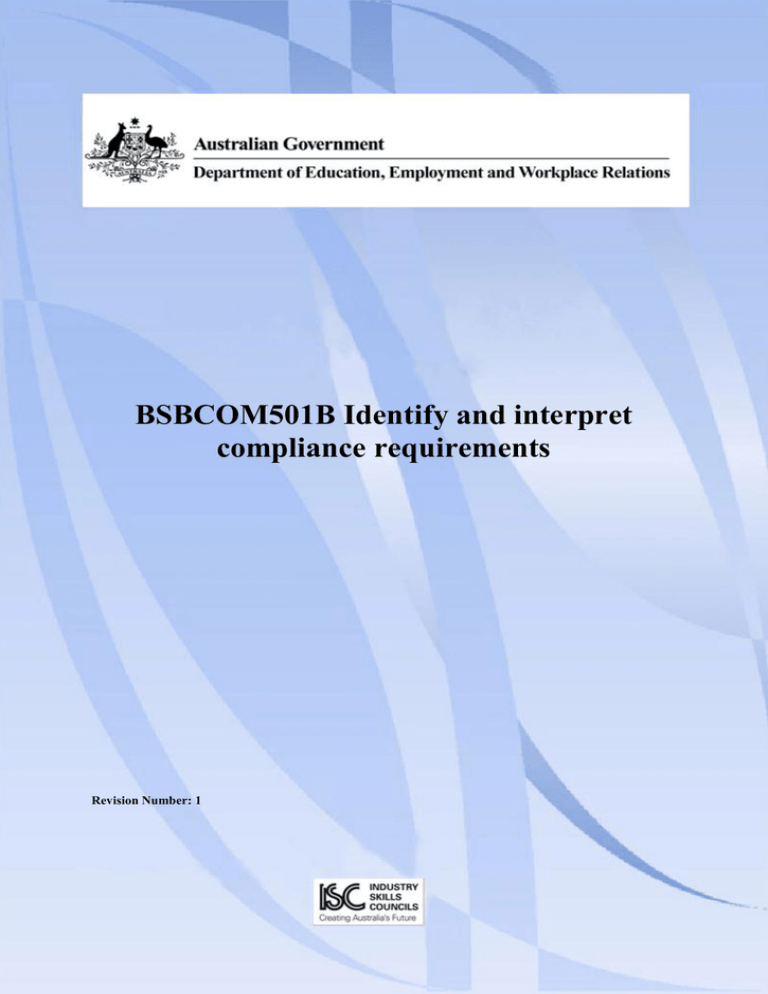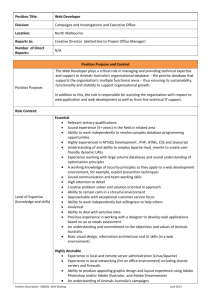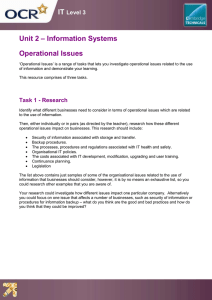BSBCOM501B Identify and interpret compliance
advertisement

BSBCOM501B Identify and interpret compliance requirements Revision Number: 1 BSBCOM501B Identify and interpret compliance requirements Date this document was generated: 26 May 2012 BSBCOM501B Identify and interpret compliance requirements Modification History Not applicable. Unit Descriptor Unit descriptor This unit describes the performance outcomes, skills and knowledge required to identify and interpret the range of internal and external compliance requirements and obligations that must be fulfilled by an organisation. A range of legislation, rules, regulations and codes of practice may apply to this unit at the time of endorsement, depending on job roles and jurisdictions. Approved © Commonwealth of Australia, 2012 Page 2 of 13 Innovation and Business Skills Australia BSBCOM501B Identify and interpret compliance requirements Date this document was generated: 26 May 2012 Application of the Unit Application of the unit This unit applies to individuals working as a chief executive or manager in a small organisation (where it would be part of their broad role) or as a member of a compliance management team within a larger organisation. These individuals require a sound theoretical knowledge of compliance and well established skills in identifying and interpreting compliance requirements relevant to the operations and sphere of business of the organisation and/or industry sector concerned. The unit also applies to internal or external consultants as part of a broader advisory role to the chief executive or management team of a large or small organisation on compliance management policies and systems. As the activities are focused primarily on identifying and interpreting specific legislative requirements, codes of practice, and internal standards and procedures as they relate to a particular organisation, this unit differs from BSBCOM601B Research compliance requirements and issues. Researching compliance issues is a higher order competence aimed at carrying out research into a wider range of compliance-related issues, such as the costs of compliance, the potential impact of compliance on an organisation or industry, and the risks and consequences of non-compliance. Licensing/Regulatory Information Not applicable. Pre-Requisites Prerequisite units Approved © Commonwealth of Australia, 2012 Page 3 of 13 Innovation and Business Skills Australia BSBCOM501B Identify and interpret compliance requirements Date this document was generated: 26 May 2012 Employability Skills Information Employability skills This unit contains employability skills. Elements and Performance Criteria Pre-Content Elements describe the essential outcomes of a unit of competency. Approved © Commonwealth of Australia, 2012 Performance criteria describe the performance needed to demonstrate achievement of the element. Where bold italicised text is used, further information is detailed in the required skills and knowledge section and the range statement. Assessment of performance is to be consistent with the evidence guide. Page 4 of 13 Innovation and Business Skills Australia BSBCOM501B Identify and interpret compliance requirements Date this document was generated: 26 May 2012 Elements and Performance Criteria ELEMENT PERFORMANCE CRITERIA 1. Clarify the scope of operations 1.1. Identify and review the relevant range of operations and the sphere of business arrangements of the organisation 1.2. Conduct an analysis of the operations and business arrangements of the organisation and identify the functions, products and services that may be subject to compliance requirements 1.3. Develop and document work activity plans for determining relevant compliance requirements 1.4. Obtain approval of plans from relevant organisational personnel 2. Identify compliance requirements 2.1. Conduct a search of information on internal and external compliance requirements using appropriate search resources, including relevant Australian and international standards 2.2. Ensure the search of compliance requirements scans across all relevant jurisdictions of laws, regulations, and industry and organisational codes and standards and identify pertinent compliance requirements 2.3. Progressively review information collected in terms of its relevance to the organisation's operations, services and products 2.4. Organise and store gathered information on relevant compliance requirements in an appropriate format for further analysis 3. Interpret, analyse and prioritise identified compliance requirements 3.1. Review and interpret collected information in terms of its relevance to the organisation's functions, services and products 3.2. Discuss and clarify with relevant internal or external personnel ambiguities, uncertainties and problems experienced in interpreting identified compliance information 3.3. Identify, analyse and prioritise relevant compliance requirements in terms of critical implications for the organisation and risks and consequence of possible breaches 3.4. Group pertinent compliance requirements into those that are critical and central to the organisation's operations, those that are important in some circumstances but are not central to the Approved © Commonwealth of Australia, 2012 Page 5 of 13 Innovation and Business Skills Australia BSBCOM501B Identify and interpret compliance requirements ELEMENT Date this document was generated: 26 May 2012 PERFORMANCE CRITERIA organisation's operations, and those that are pertinent but are incidental to the organisation's operations 4. Document compliance requirements Approved © Commonwealth of Australia, 2012 4.1. Organise and document outcomes of the identification and interpretation activities 4.2. Prepare and communicate reports of relevant compliance requirements and assessment of implications to relevant personnel performing specific compliance management functions Page 6 of 13 Innovation and Business Skills Australia BSBCOM501B Identify and interpret compliance requirements Date this document was generated: 26 May 2012 Required Skills and Knowledge REQUIRED SKILLS AND KNOWLEDGE This section describes the skills and knowledge required for this unit. Required skills interpersonal skills to: contribute to the development of a positive culture of compliance within an organisation work with internal and external personnel with an interest in an organisation's compliance program and management system interpersonal and communication skills to relate to internal and external personnel, including those representing relevant regulatory authorities, professional institutes and organisations, including standards' organisations literacy skills to read and interpret various types of documents and to write reports containing complex concepts organisational and time-management skills to conduct compliance management activities project management skills to: scope and plan the conduct of compliance requirement identification activities manage other personnel involved in the identification and interpretation of compliance management activities research and analytical skills to identify and interpret compliance requirements technical skills to use communications technology effectively Required knowledge elements of compliance programs and related management systems, including: documentation of compliance requirements relevant to the organisation specification of compliance management functions, accountabilities and responsibilities within the organisation compliance-related management information systems record-keeping systems required for compliance management liaison procedures with relevant internal and external personnel on compliance-related matters breach management policies and processes, including the identification, classification, investigation, rectification and reporting of breaches in compliance requirements compliance reporting procedures corporate induction and training processes related to compliance management processes for the internal and external distribution and promotion of information on compliance requirements, and compliance programs and management systems Approved © Commonwealth of Australia, 2012 Page 7 of 13 Innovation and Business Skills Australia BSBCOM501B Identify and interpret compliance requirements Date this document was generated: 26 May 2012 REQUIRED SKILLS AND KNOWLEDGE complaints handling systems continuous improvement processes for compliance, including monitoring, evaluation and review strategies for developing a positive compliance culture within the organisation techniques and performance indicators for monitoring the operation of a compliance program or management system reporting processes on compliance management, including reports on breaches and rectification action relevant organisational policies and procedures, including: compliance plans and policies in various compliance areas organisational standards for operations and ethics relevant Australian and international standards, including: AS 3806:2006 Compliance programs AS ISO 10002:2006 Customer satisfaction - Guidelines for complaints handling in organizations AS ISO 15489:2004 Records management AS/NZS 4360:2004 Risk management relevant organisational policies and procedures, including: plans and policies in various compliance areas organisational standards for operations and ethics Approved © Commonwealth of Australia, 2012 Page 8 of 13 Innovation and Business Skills Australia BSBCOM501B Identify and interpret compliance requirements Date this document was generated: 26 May 2012 Evidence Guide EVIDENCE GUIDE The Evidence Guide provides advice on assessment and must be read in conjunction with the performance criteria, required skills and knowledge, range statement and the Assessment Guidelines for the Training Package. Overview of assessment Critical aspects for assessment and evidence required to demonstrate competency in this unit Evidence of the ability to: Context of and specific resources for assessment Assessment must ensure access to: Method of assessment document processes used to identify, analyse and interpret organisational compliance requirements apply knowledge of elements of compliance programs and related management systems. organisational policies and procedures, standard operating procedures, and plans relevant published material on legislation, regulations, licensing requirements, codes of practice, standards, etc. appropriate computer resources for online searching and review of relevant compliance requirements. A range of assessment methods should be used to assess practical skills and knowledge. The following examples are appropriate for this unit: observation of activities undertaken to identify compliance requirements assessment of reports identifying compliance requirements and containing analysis of the implications of those requirements on organisational objectives, processes and systems direct questioning combined with review of portfolios of evidence and third-party workplace reports of on-the-job performance by the candidate observation of interactions with internal and external stakeholders while identifying compliance requirements oral or written questioning to assess knowledge of compliance requirements and their impact on organisational objectives, processes and systems review of authenticated compliance promotional documents or computer files from the workplace or training environment. Guidance information for Holistic assessment with other units relevant to the industry sector, workplace and job role is recommended. assessment Approved © Commonwealth of Australia, 2012 Page 9 of 13 Innovation and Business Skills Australia BSBCOM501B Identify and interpret compliance requirements Date this document was generated: 26 May 2012 Range Statement RANGE STATEMENT The range statement relates to the unit of competency as a whole. It allows for different work environments and situations that may affect performance. Bold italicised wording, if used in the performance criteria, is detailed below. Essential operating conditions that may be present with training and assessment (depending on the work situation, needs of the candidate, accessibility of the item, and local industry and regional contexts) may also be included. Range of operations may include: Compliance requirements may include: Approved © Commonwealth of Australia, 2012 full range of operations of an organisation at a particular site full range of operations of an organisation distributed across multiple sites full range of operations of an organisation, including mobile units such as vehicles, railway trains, maritime vessels and aircraft operations of a particular section or organisational unit. cross-industry, industry-specific and internal organisational compliance requirements in such areas as (examples in alphabetical groupings): anti-discrimination, including discrimination by race, sex, disability, religion, etc.; alcohol licensing, including licensing regulations covering clubs, pubs, licensed premises, etc.; aviation bankruptcy chemical use, child protection, construction, conveyancing/real estate, copyright, corporate governance, customs, credit education, electricity, environmental protection, equal opportunity financial services, including banking; fire; food hygiene; freedom of information; freight forwarding gambling, gene technology health, human rights insurance, immigration, intellectual property land management maritime, mining pharmaceuticals, patents, privacy quarantine racing, rail transport, road transport safety, including cross-industry generic regulations as well as industry, equipment or product-specific subcategories, e.g. marine safety, rail safety, food Page 10 of 13 Innovation and Business Skills Australia BSBCOM501B Identify and interpret compliance requirements Date this document was generated: 26 May 2012 RANGE STATEMENT Information on internal and external compliance requirements may include: Search resources may include: Relevant Australian and international standards may include: Jurisdictions of laws, regulations, industry and organisational codes and standards Approved © Commonwealth of Australia, 2012 safety, aviation safety, road safety, dangerous goods, construction safety, mine safety, etc.; security; sewage; superannuation taxation, telecommunications, tobacco, trade practices and consumer protection water supply, workers compensation, workers rehabilitation different types of internal and external compliance requirements, including: accreditation requirements of an institute, professional organisation or registration body internal policies, procedures, standards or codes of practice of an organisation regulations of a state or territory, national or international regulatory authority requirements for certification under statutory licensing systems statutory standards or codes of practice. internal policies, standard operating procedures, standards, and codes of practice published material relevant to compliance held in either internal or external libraries relevant legislation, regulations and licensing requirements pertinent to the organisation's operations and sphere of business. computer terminals linked to data sources either via the internet, internal networks, or CDs library resources and materials, including compliance-related books, journals, manuals, standards, CDs and other multimedia resources published information on such things as relevant legislation, regulations, licensing requirements, codes of practice and Australian standards. AS 3806:2006 Compliance programs AS ISO 10002:2006 Customer satisfaction - Guidelines for complaints handling in organizations AS ISO 15489:2004 Records management AS/NZS 4360:2004 Risk management. global industry local Page 11 of 13 Innovation and Business Skills Australia BSBCOM501B Identify and interpret compliance requirements Date this document was generated: 26 May 2012 RANGE STATEMENT may include: Information on relevant compliance requirements may include: Relevant internal personnel may include: Relevant external personnel may include: Relevant personnel performing specific compliance management functions may include: national organisational state or territory. correspondence, emails and other written information provided by internal and external personnel contacted during search activities information downloadable from relevant websites newsletters, bulletins and information sheets and other similar periodic documentation distributed by relevant regulatory authorities and standards bodies published information on legislation, regulations, codes of practice, standards, licensing requirements, standard operating procedures, etc. records of conversations and meetings with relevant internal and external personnel. board of directors chief executive officer compliance management team compliance specialists at the operational level frontline managers senior management team. legal and business advisors and consultants with expertise in compliance management representatives of professional associations and institutes relevant to the organisation's operations and sphere of business representatives of relevant authorities in pertinent compliance areas. compliance management consultants compliance management officers compliance managers legal personnel specialising in compliance management line managers with specific compliance functions. Unit Sector(s) Unit sector Approved © Commonwealth of Australia, 2012 Page 12 of 13 Innovation and Business Skills Australia BSBCOM501B Identify and interpret compliance requirements Date this document was generated: 26 May 2012 Competency field Competency field Regulation, licensing and risk - compliance Co-requisite units Co-requisite units Approved © Commonwealth of Australia, 2012 Page 13 of 13 Innovation and Business Skills Australia



